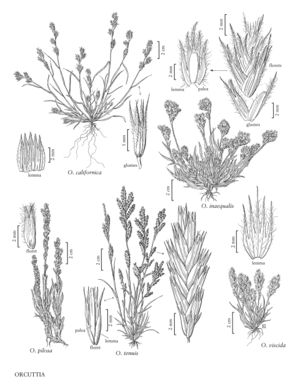Difference between revisions of "Orcuttia californica"
imported>Volume Importer |
imported>Volume Importer |
||
| Line 37: | Line 37: | ||
|publication year= | |publication year= | ||
|special status= | |special status= | ||
| − | |source xml=https:// | + | |source xml=https://bitbucket.org/aafc-mbb/fna-data-curation/src/2e0870ddd59836b60bcf96646a41e87ea5a5943a/coarse_grained_fna_xml/V25/V25_943.xml |
|subfamily=Poaceae subfam. Chloridoideae | |subfamily=Poaceae subfam. Chloridoideae | ||
|tribe=Poaceae tribe Orcuttieae | |tribe=Poaceae tribe Orcuttieae | ||
Revision as of 22:06, 5 November 2020
Plants sparsely hairy. Culms 5-15(20) cm, simple, sometimes geniculate, usually prostrate and forming mats. Leaves with a faint "collar" line usually evident when dry; blades 1-2 cm long, 2-3 mm wide. Spikes 3-6 cm; lower internodes 5-10 mm; upper internodes about 1 mm. Spikelets with 5-15(25) florets. Glumes subequal or the lower glumes a little shorter than the upper, 2-3(4) mm, irregularly toothed; lemmas about 5 mm, teeth equal or the central tooth a little longer than the others, awns to 0.5 mm; paleas about equal to the lemmas; anthers about 2 mm. Caryopses 1.5-1.8 mm, narrowly elliptical; embryos at least 3/4 as long as the caryopses. 2n = 32.
Distribution
Calif.
Discussion
Orcuttia californica grows at elevations below 625 m in Los Angeles, Riverside, and San Diego counties, California and northern Baja California, Mexico. It is listed as an endangered species by the U.S. Fish and Wildlife Service.
Selected References
None.
